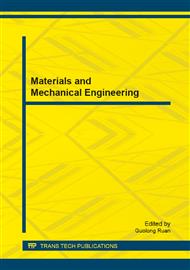p.138
p.144
p.149
p.153
p.162
p.168
p.175
p.181
p.185
Qualitative Study on Mechanical Environment Affecting the Degradation of the Magnesium Alloys
Abstract:
Objective Explore the degradation rule of the magnesium alloys in simple mechanical environment. Methods Select a kind of magnesium alloy of better degradation by experiment and prepare screws. The experiment totally contains five groups, they are control group one with no specific conditions, experimental group two with 0.1Mpa external pressure, experimental group three with 0.2Mpa external pressure, pig femoral experimental group four with 0.2N shear force, pig femoral experimental group five with 0.3N shear force. Record the volume of hydrogen every certain time interval and observe the surface morphology of magnesium alloy screws through Object Deformation Image Capture System when the experiment is over to reflect the degradation rate of magnesium alloys. And the experiment would be repeated once to ensure the test results. Results Compared to group one, when external pressure exists, the volume of hydrogen significantly increases. Group two and group three have no significant difference in results, but group three has a greater degree of degradation than group two by observing the surface morphology. The volume of hydrogen of group four and group five is smaller than that of the first group in that smaller volume of screws exposes in SBF. The volume of hydrogen of the fifth group is greater than that of group four. Group five has a greater degree of degradation than the fourth group by observing the surface morphology. The repeated experiment basically keeps the same conditions, but the volume of hydrogen of group three is greater than that of group two.Conclusion Mechanical environment has an impact on the degradation rate of magnesium alloys. The pressure of the environment affects the degradation rate of magnesium alloys. The greater the pressure, the faster the degradation rate. The external force affects degradation rate of magnesium alloys. The greater the shear force, the faster the degradation rate.
Info:
Periodical:
Pages:
162-167
Citation:
Online since:
February 2014
Authors:
Price:
Сopyright:
© 2014 Trans Tech Publications Ltd. All Rights Reserved
Share:
Citation:


